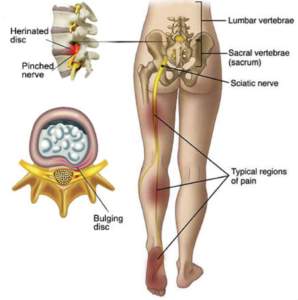
There are five nerve points where pain distribution can occur (all through the lumbar portion of the spine): L1 = groin, L2 = upper thigh, L3 = middle thigh, L4 = knee, L5 = shin, top of the foot, and big toe. Then the sacral portion, S1 = lateral calf, heel, and bottom of the foot (this is caused by a herniated disc and annular tear). Sciatica is a condition of the irritation or compression of one or more nerve roots in the lumbar spine. Since these nerves travel to the hips, buttocks, legs, and feet, an injury in the lumbar spine can cause symptoms in these areas. Sciatica might be a symptom of a “pinched nerve” affecting one or more of the lower spinal nerves. The nerve might be pinched inside or outside of the spinal canal as it passes into the leg. Chronic pain is a complication of untreated sciatica. If the “pinched nerve” is seriously injured, chronic muscle weakness, such as “drop foot”, might occur.
Conditions that can cause sciatica include: